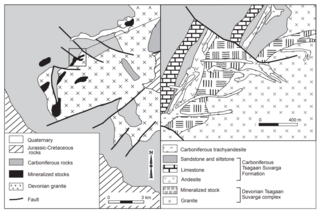Related Research Articles

Uvs Lake is a highly saline lake in an endorheic basin—Uvs Nuur Basin, primarily in Mongolia with a smaller part in Russia. It is the largest lake in Mongolia by surface area, covering 3,350 km2 at 759 m above sea level. The northeastern tip of the lake is situated in the Tuva Republic of the Russian Federation. The largest settlement near the lake is Ulaangom. This shallow and very saline body of water is a remainder of a huge saline sea which covered a much larger area several thousand years ago.
Nogoonnuur is a sum (district) of Bayan-Ölgii Province in western Mongolia. It is primarily inhabited by ethnic Kazakhs. As of 2014 it had a population of 6003 people.
Chandgana Tal is a coal mine in the Mörön sum (district) of Khentii Province in eastern Mongolia.

The Daurian Nature Reserve is a Russian zapovednik situated in the southern part of Zabaykalsky Krai in Siberia, Russia, close to the border with Mongolia. It is part of a World Heritage Site named "The Landscapes of Dauria".

The wildlife of Mongolia consists of flora, fauna and funga found in the harsh habitats dictated by the diverse climatic conditions found throughout the country. In the north, there are salty marshes and fresh-water sources. The centre has desert steppes. In the south, there are semi deserts as well as the hot Gobi desert in the south, the fifth-largest desert in the world.

Mining is important to the national economy of Mongolia. Mongolia is one of the 29 resource-rich developing countries identified by the International Monetary Fund and exploration of copper and coal deposits are generating substantial additional revenue. Coal, copper, and gold are the principal reserves mined in Mongolia. Several gold mines are located about 110 kilometres (68 mi) north of Ulaanbaatar, such as Boroo Gold Mine and Gatsuurt Gold Mine. Khotgor Coal Mine is an open-pit coal mining site about 120 kilometres (75 mi) west of Ulaangom. Ömnögovi Province in the south of Mongolia is home to large scale mining projects such as the Tavan Tolgoi coal mine and the Oyu Tolgoi copper mine. Oyu Tolgoi mine is reported to have the potential to boost the national economy by a third but is subject to dispute over how the profits should be shared. The International Monetary Fund (IMF) has estimated that 71 percent of the income from the mine would go to Mongolia.
The Halzan Buregtei mine is a large mine located in the northern part of Mongolia in Khovd Province. Halzan Buregtei represents one of the largest tantalum reserves in Mongolia having estimated reserves of 218.8 million tonnes of ore grading 0.016% tantalum.

The Tsagaan Suvarga mine is a copper ore deposit and mine in development located in the Mandakh sum of Dornogovi aimag in the south of Mongolia.
The Övdög Khudag Coal Mine is a coal mine being developed in the Bayanjargalan sum of the Dundgovi in southern central Mongolia. The deposit has coal reserves amounting to projected 89 million tonnes of Lignite. Together with the "Ikh ulaan uul" deposit nearby it comprises the "Black Hills" development.
The Nuurst Khotgor Coal Mine is an open-pit coal mine, located about 80 km west of the Uvs Province capital Ulaangom and 25 km south of Üüreg Lake in Bökhmörön sum (district) of Uvs Province in western Mongolia.
The Aduunchuluun Coal Mine, also written as "Aduun Chuluun" coal mine is a coal mine located next to Choibalsan city in Dornod aimag of eastern Mongolia. The mine has coal reserves amounting to 423.8 million tonnes of coking coal, one of the largest coal reserves in Asia and the world. The mine has an annual production capacity of 0.6 million tonnes of coal. Owner is the Mongolyn Alt Corporation (MAK).
The Khuut Coal Mine is a coal mine located in the Matad sum of Dornod aimag in eastern Mongolia.
The Tsaidam Lake Coal Mine is a coal mine being developed in the Bayan sum of Töv aimag in central Mongolia.
The Ulaan mine is one of the largest lead and zinc mines in Mongolia. The mine is located in southern Mongolia. The mine has reserves amounting to 38.8 million tonnes of ore grading 1.09% lead and 1.9% zinc thus resulting 0.42 million tonnes of lead and 0.74 million tonnes of zinc. The mine also has reserves amounting to 256,000 oz.
The Mankhan Uul mine is a large mine in Mongolia. Ongilog Lake represents one of the largest phosphates reserve in Mongolia having estimated reserves of 1.6 billion tonnes of ore grading 35% P2O5.
The Ulaan-Uul mine is an underground mine located in the Nogoonnuur sum of Khovd aimag in western Mongolia.
The Tugrugnuur Coal Mine is a coal mine located in eastern Mongolia. The mine has coal reserves amounting to 3.12 billion tonnes of coking coal, one of the largest coal reserves in Asia and the world. The mine has an annual production capacity of 0.05 million tonnes of coal.
The Tamir gol mine is an iron mine located in the Tüvshrüülekh sum of Arkhangai aimag in central Mongolia.
The Erds Coal Mine is a coal mine located in eastern Mongolia. The mine has coal reserves amounting to 807 million tonnes of coking coal, one of the largest coal reserves in Asia and the world. The mine has an annual production capacity of 0.1 million tonnes of coal.
The Khovd Gol mine is an underground mine located in the Tsengel sum of Khovd aimag in western Mongolia.
References
- ↑ "Ongilog Lake Mine, Mongolia" (PDF). resources.newsresources.info. 2012. Archived from the original (PDF) on 2014-02-25. Retrieved 2013-07-09.